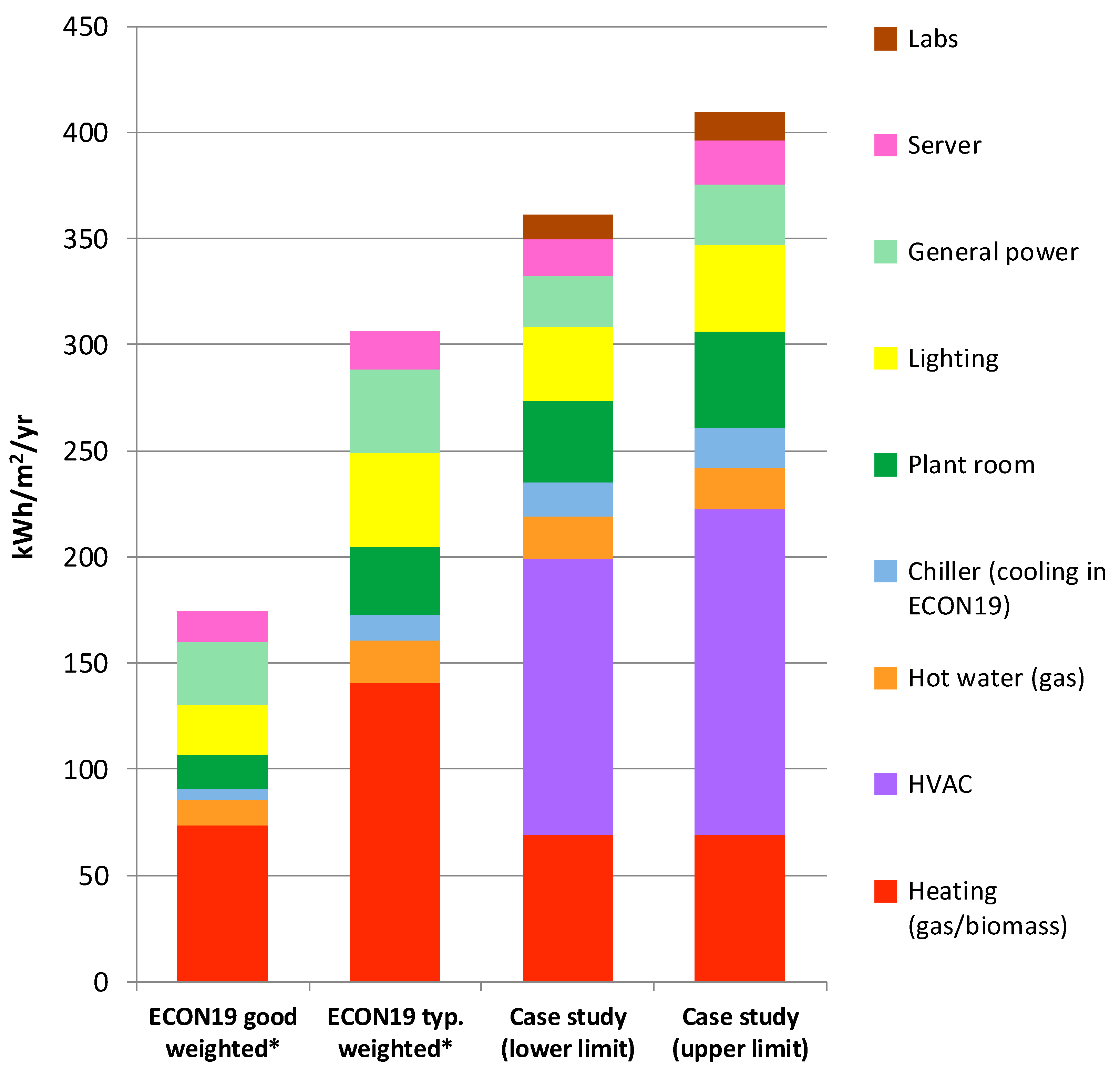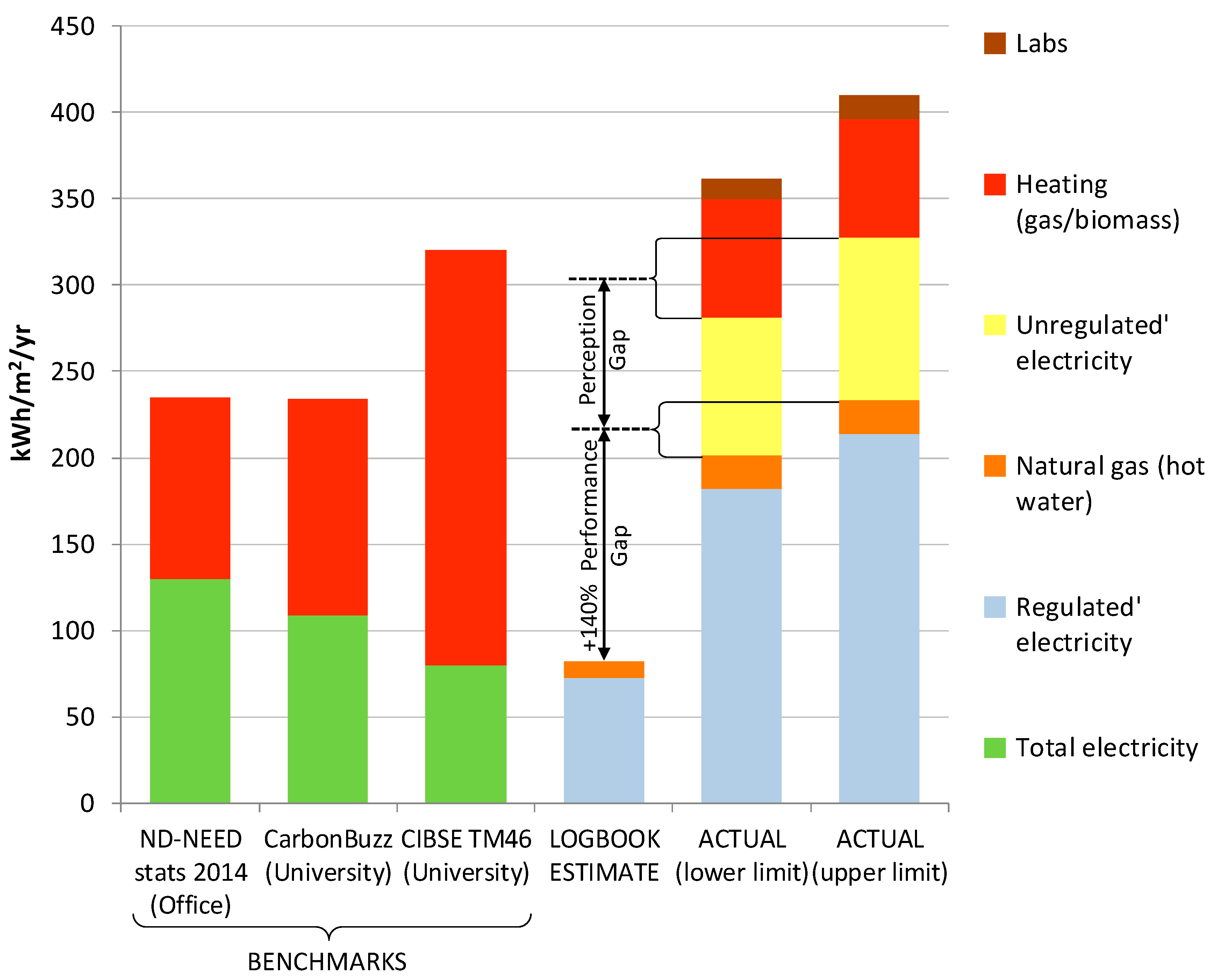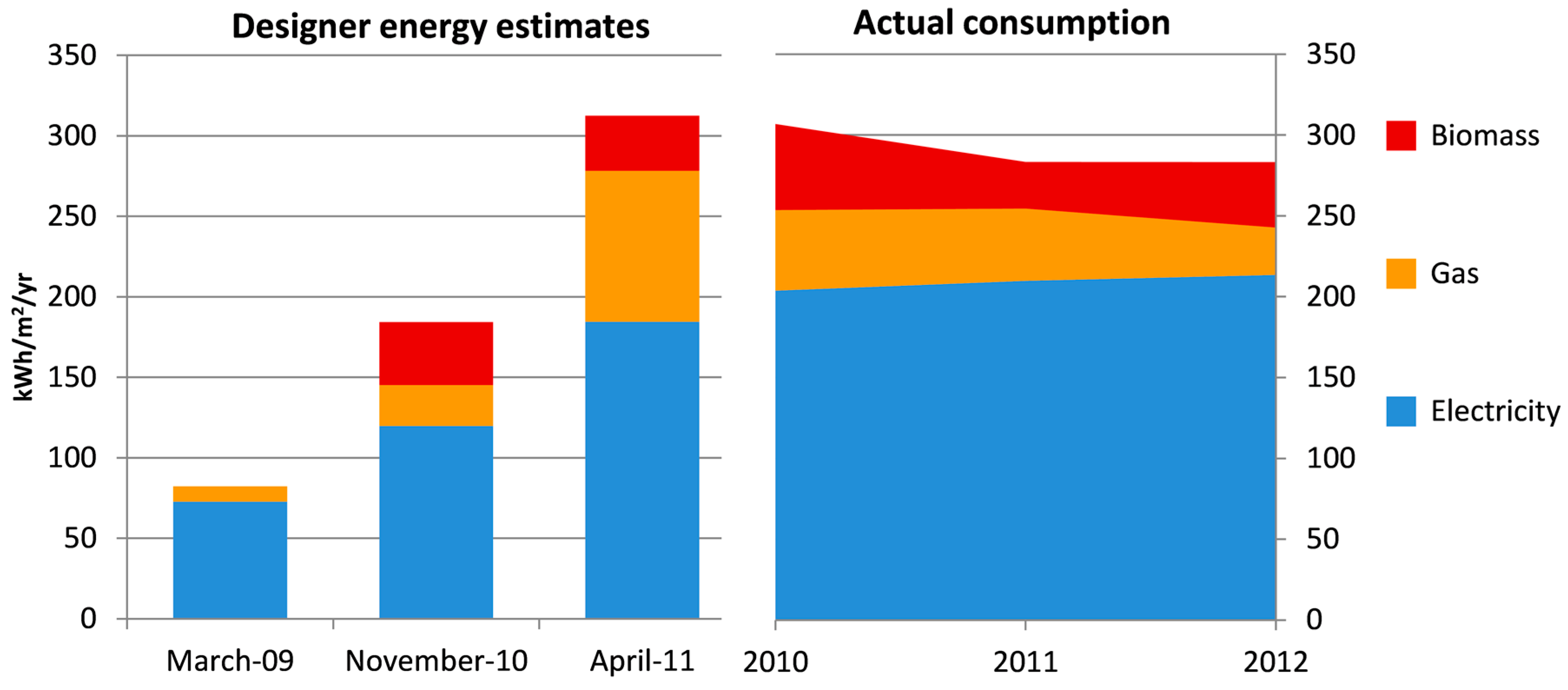Realising Operational Energy Performance in Non-Domestic Buildings: Lessons Learnt from Initiatives Applied in Cambridge
Abstract
:1. Introduction
2. Methodology
2.1. Case Study Building
2.2. Energy Analysis Approach
- The ND-NEED benchmark reveals non-domestic building energy use intensity for electricity and gas from a database covering in excess of 20% of all non-domestic buildings in the UK. The relevant data for this research were collected in 2011, for office buildings between 1000 and 4999 m2 [16].
- CarbonBuzz draws upon open source case study building data contributed by building professionals and represents a dynamic database for university buildings. In this case, the reported actual consumption is used as the benchmark, although prediction data are also available.
- CIBSE TM46 describes the statutory building energy benchmarks to complement the DEC rating procedure, again for university buildings [17].
3. Review of Energy Performance Initiatives Used in Case Study
3.1. The Building Regulations UK Part L (BRUKL)
3.2. BREEAM New Construction
3.3. Soft Landings Cambridge Work Plan
4. Results
4.1. Energy Use Compared to Benchmarks
- electricity for naturally ventilated spaces;
- electricity for mechanically ventilated spaces; and
- natural gas for hot water use.
4.1.1. Energy Consumption Guide 19 for Offices (ECON19)
4.1.2. Low End-Use Resolution Benchmarks
4.1.3. Designer Energy Estimates Prior and during Early Operation
4.2. Review of Soft Landings Cambridge Work Plan
4.3. Review of BREEAM
4.4. Review of the UK Building Regulations Part L (BRUKL) Implementation of the EU Energy Performance of Buildings Directive (EPBD)
5. Discussion
5.1. Alternative Initiatives to Address Building Energy Efficiency in Operation
5.1.1. Passivhaus Voluntary Building Rating Scheme
5.1.2. Living Building Challenge Voluntary Building Rating System
5.1.3. CIBSE TM54: Evaluating Operational Energy Performance at the Design Stage
5.1.4. CIBSE TM22 Energy Assessment and Reporting Methodology
5.2. Lessons Learnt from Case Study Building and Potential of Alternative Energy Performance Initiatives
5.2.1. Implementation and Revision of Client Building Policy
5.2.2. Capitalising upon Energy Data in Practice
5.3. Building Portfolio Management
6. Conclusions
Author Contributions
Conflicts of Interest
References
- Department of Energy and Climate Change. 2010 to 2015 Government Policy: Greenhouse Gas Emissions. Available online: https://www.gov.uk/government/publications/2010-to-2015-government-policy-greenhouse-gas-emissions/2010-to-2015-government-policy-greenhouse-gas-emissions (accessed on 25 July 2017).
- European Parliament Directive. 2010/31/EU of the European Parliament and of the Council of 19 May 2010 on the Energy Performance of Buildings. Off. J. Eur. Union 2010, 1, 1–16. [Google Scholar]
- Carbon Trust. Closing the Gap—Lessons Learned on Realising the Potential of Low Carbon Building Design; Queen’s Printer: London, UK, 2012. [Google Scholar] [CrossRef]
- Bordass, B.; Cohen, R.; Field, J. Energy Performance of Non-Domestic Buildings: Closing the Credibility Gap. Presented at the Building Performance Congress, Frankfurt, Germany, 19–22 April 2004. [Google Scholar]
- Bordass, B.; Cohen, R.; Standeven, M.; Leaman, A. Assessing building performance in use 3: Energy performance of the Probe buildings. Build. Res. Inf. 2001, 29, 114–128. [Google Scholar] [CrossRef]
- Palmer, J.; Terry, N.; Armitage, P. Building Performance Evaluation Programme: Findings from Non-Domestic Projects; Innovate UK: Swindon, UK, 2016; 75p. [Google Scholar]
- Royal Institute of British Architects; Chartered Institution of Building Services Engineers. CarbonBuzz: Evidence. Available online: http://www.carbonbuzz.org/evidencetab.jsp (accessed on 25 July 2017).
- Forman, T.; Mutschler, R.; Guthrie, P.; Soulti, E.; Pickering, B.; Byström, V; Lee, S.M. Improving Building Energy Performance in Universities: The Case Study of the University of Cambridge. In Handbook of Theory and Practice of Sustainable Development in Higher Education; Leal Filho, W., Brandli, L., Castro, P., Newman, J., Eds.; Springer International Publishing: Cham, Germany, 2017; Volume 1, pp. 245–266. [Google Scholar]
- Cohen, R.; Standeven, M.; Bordass, B.; Leaman, A. Assessing building performance in use 1: The Probe process. Build. Res. Inf. 2001, 29, 85–102. [Google Scholar] [CrossRef]
- Menezes, A.C.; Cripps, A.; Bouchlaghem, D.; Buswell, R. Predicted vs. actual energy performance of non-domestic buildings: Using post-occupancy evaluation data to reduce the performance gap. Appl. Energy 2012, 97, 355–364. [Google Scholar] [CrossRef] [Green Version]
- Woods, J. Department of Engineering Institute for Manufacturing Post Occupancy Evaluation. Unpublished work. 2011. [Google Scholar]
- Way, M. University of Cambridge Estate Management and Building Services Soft Landings Workplan. Unpublished work. 2006. [Google Scholar]
- Usable Buildings Trust; Bunn, R. The Soft Landings Core Principles; BSRIA: Bracknell, UK, 2014. [Google Scholar]
- BIM Task Group. Government Soft Landings; Cabinet Office: London, UK, 2013.
- Building Research Energy Conservation. Energy Consumption Guide 19—Energy Use in Offices; Chartered Institution of Building Services Engineers: London, UK, 2003; pp. 1–24. [Google Scholar]
- Department of Energy and Climate Change. The Non-Domestic National Energy Efficiency Data Framework (ND-NEED); DECC: London, UK, 2014. [Google Scholar]
- Field, J. CIBSE TM46:2008. Energy Benchmarks; The Chartered Institution of Building Services Engineers: London, UK, 2008. [Google Scholar]
- Kelly, S.; Crawford-Brown, D.; Pollitt, M.G. Building performance evaluation and certification in the UK: Is SAP fit for purpose? Renew. Sustain. Energy Rev. 2012, 16, 6861–6878. [Google Scholar] [CrossRef]
- Department for Communities and Local Government. Display Energy Certificates and Advisory Reports for Public Buildings; Department for Communities and Local Government: London, UK, 2015.
- Cole, R.J.; Valdebenito, M.J. The importation of building environmental certification systems: International usages of BREEAM and LEED. Build. Res. Inf. 2013, 41, 662–676. [Google Scholar] [CrossRef]
- Lee, W.L. Benchmarking energy use of building environmental assessment schemes. Energy Build. 2012, 45, 326–334. [Google Scholar] [CrossRef]
- Tuohy, P.G.; Murphy, G.B. Are current design processes and policies delivering comfortable low carbon buildings? Archit. Sci. Rev. 2014, 58, 39–46. [Google Scholar] [CrossRef] [Green Version]
- Parker, J. The Value of BREEAM; BSRIA: London, UK, 2012. [Google Scholar]
- De Wilde, P. The gap between predicted and measured energy performance of buildings: A framework for investigation. Autom. Constr. 2014, 41, 40–49. [Google Scholar] [CrossRef]
- Newsham, G.; Mancini, S.; Birt, B. Do LEED-certified buildings save energy? Yes, but…. Energy Build. 2009, 41, 897–905. [Google Scholar] [CrossRef]
- Way, M.; Bordass, B. Making feedback and post-occupancy evaluation routine 2: Soft landings—Involving design and building teams in improving performance. Build. Res. Inf. 2005, 33, 353–360. [Google Scholar] [CrossRef]
- Usable Buildings Trust; Way, M.; Bunn, R. The Soft Landings Framework—For Better Briefing, Design, Handover and Building Perfomance In-Use; BSRIA: London, UK, 2014. [Google Scholar]
- Austin, B. The Performance Gap: Causes & Solutions. Green Construction Board Buildings Working Group; ARUP: London, UK, 2013. [Google Scholar]
- University of Cambridge Estate Management and Building Services. IfM Energy Key Performance Indicators; University of Cambridge: Cambridge, UK, 2013. [Google Scholar]
- Norris, T. Bridging the Gap Between Designed and Real Consumption: What Can the University of Cambridge Teach Us about Energy Reporting and Monitoring? Bachelor’s Thesis, University of Cambridge, Cambridge, UK, 2014, unpublished. [Google Scholar]
- Bordass, B.; Leaman, A. Making feedback and post-occupancy evaluation routine 1: A portfolio of feedback techniques. Build. Res. Inf. 2005, 33, 347–352. [Google Scholar] [CrossRef]
- University of Cambridge. The Design and Construction of Environmentally Sustainable New Buildings. Available online: http://www.environment.admin.cam.ac.uk/resource-bank/guidance-documents/design-and-construction-environmentally-sustainable-new-buildings#heading1.0 (accessed on 25 July 2017).
- Boyce, H. IfM Energy Performance Certificate 0510-0931-9300-2022-4006. Available online: https://www.ndepcregister.com/ReportDownload?rrn=0510-0931-9300-2022-4006&repType=EPC&lc=1&source=0&lang=en (accessed on 25 July 2017).
- Passive House Institute. Passive House Database. Available online: http://www.passivhausprojekte.de/index.php (accessed on 25 July 2017).
- Feist, W. Certification as “Quality Approved Passive House” Criteria for Non-Residential Passive House Buildings; Passivhaus-Institut: Darmstadt, Germany, 2009. [Google Scholar]
- Parker, N. A Comparison of Green Building Rating Systems: Living Building Challenge 2.0. In Proceedings of the Annual Conference of the Canadian Society for Civil Engineering, Edmonton, AB, Canada, 6–9 June 2012. [Google Scholar]
- International Living Future Institute. Living Building Challenge 3.1 Standard. Available online: http://living-future.org/lbc (accessed on 25 July 2017).
- International Living Future Institute. Zero Energy Certification. Available online: https://living-future.org/net-zero/certification/ (accessed on 25 July 2017).
- Cheshire, D.; Menezes, A.C. Evaluating Operational Energy Performance of Buildings at the Design Stage; CIBSE TM54:2013; The Chartered Institution of Building Services Engineers London: London, UK, 2013; ISBN 978-1-906846-38-1. [Google Scholar]
- Cohen, R. TSB BPE: Reporting Non Domestic Building Energy Performance after a TM22 Analysis; Innovate UK: Swindon, UK, 2013; pp. 1–8. [Google Scholar]
- University of Cambridge Estate Management and Building Services. Carbon Management Plan 2010–2020; University of Cambridge: Cambridge, UK, 2010. [Google Scholar]
- University of Cambridge Environment and Energy. Behavioural Change: Gurdon Institute. Available online: http://www.environment.admin.cam.ac.uk/resource-bank/case-studies/case-studies-energy-and-carbon-reduction/behavioural-change-gurdon (accessed on 25 July 2017).



| Energy Consumption Guide 19 (ECON19) | TM46 Energy Benchmarks (Used in DECs) | CarbonBuzz | Non-Domestic National Energy Efficiency Database (ND-NEED) | |
|---|---|---|---|---|
| Developer | BRECSU | CIBSE | RIBA and CIBSE | Department of Energy and Climate Change |
| Established | 1995 | 2008 | 2008 | 2014 |
| Building categories | 4 | 29 | 35 | 5 |
| Number of end-uses | 11 | 2 | 2 | 2 |
| Benchmark data collection period | Mid 1990s | Pre-2007 | 2008–present | 2006–2011 |
| Statistical data | X | X | X | |
| Crowd sourced | X | |||
| Open access | X | X | ||
| Cross-references | CIBSE Guide F, ECON19 | CIBSE TM46 reference |
| Key Deliverables | Requirements (Design Intent) | Observations from Minutes | Evidence |
|---|---|---|---|
| Pre-Handover Stage | Before User Occupancy | ||
| Commissioning time | Allocated time between build completion and occupation to allow for fine-tuning of building equipment and components. | The commissioning report was an item on every meeting agenda. Commissioning appeared to be well executed with sufficient time allocated. | Good |
| Training programme for FM staff | To ensure that FM staff are adequately prepared for post-handover. | Training was arranged from specialist installers such as security systems and clean room laboratories. | Good |
| Building Management System (BMS) demonstration for FM staff | Demonstrate key facilities and trend logging to allow for future reviews of the actual performance and fine-tuning of systems. | BMS training was discussed and scheduled over several meetings. Minutes after scheduled time state that BMS training is outstanding. | Poor |
| User migration planning | Design team to assist mitigate the impact of any on-going site activities with incoming user requirements. | No evidence. | N/A |
| Arrange aftercare team “home” | Aftercare team required to assist with issues in the first weeks of occupation, and should be based in an accessible “home” where occupants can seek assistance. | A semi-permanent aftercare team home is not discussed, and meetings are held on an infrequent and irregular basis in different rooms. | Poor |
| Compile Building User Guide | To help building users to better understand and operate the building efficiently as envisaged by the design team. | Draft version of the Building User Guide is circulated and updated after feedback; however this item remains outstanding at every subsequent meeting. | Poor |
| Operations and Maintenance (O&M) | Verify content of O&M guidance to ensure completeness. | Discussed at length, and scope expanded to include the work of sub-contractors. | Good |
| Early Aftercare Stage | Immediately Post-Occupancy for 4–8 Weeks | ||
| Provide resident on-site attendance. | To respond to emerging issues. Expectation to be in attendance 1–2 days per week. | No mention was made of regular attendance during the occupancy phase-in. Additional meetings were scheduled in response to particular issues that required quick resolution. | Poor |
| Building user guidance | Provide focus group meetings with new users to disseminate building operation information. | No evidence. | Poor |
| Technical guidance | To allow for smooth transition to operation by client’s FM team. | Training from pre-occupancy phase appears to cover the specialised technical information handover. | Good |
| Communications and walkabouts. | To encourage feedback and observe occupation usage. | No evidence. | N/A |
| Aftercare Remainder Year 1 | After the “Early Aftercare Stage” Until 1 Year Post-Completion | ||
| Aftercare review meetings | Continue to have designer and constructor presence in monthly Cambridge Work Plan Meetings. | Meetings continue to be held on site after occupancy commences and official opening occurs. | Good |
| Log and review energy usage | Provide comparison against energy targets and assist fine tuning. | BMS data manually read prior to data connection to central Estate. Energy targets are not mentioned. | Poor |
| Fine tune systems and record changes in usage | To adjust for seasonal change as necessary, and make notes of any changes to system operation in the building logbook. | Seasonal commissioning scheduled as a part of preventative maintenance. Records from this are not kept in the logbook or mentioned in later minutes. | Poor |
| Commission occupant survey | Independent survey of occupant overall satisfaction. | No mention of formal survey. Instead general opinions of some user representatives are used (not independent). | Poor |
| Year 1 review | To review overall building performance and information from first year of Cambridge Work Plan. | No evidence, however the meeting records cease in January, 10 months after practical completion. | N/A |
© 2017 by the authors. Licensee MDPI, Basel, Switzerland. This article is an open access article distributed under the terms and conditions of the Creative Commons Attribution (CC BY) license (http://creativecommons.org/licenses/by/4.0/).
Share and Cite
Pritchard, R.; Kelly, S. Realising Operational Energy Performance in Non-Domestic Buildings: Lessons Learnt from Initiatives Applied in Cambridge. Sustainability 2017, 9, 1345. https://doi.org/10.3390/su9081345
Pritchard R, Kelly S. Realising Operational Energy Performance in Non-Domestic Buildings: Lessons Learnt from Initiatives Applied in Cambridge. Sustainability. 2017; 9(8):1345. https://doi.org/10.3390/su9081345
Chicago/Turabian StylePritchard, Ray, and Scott Kelly. 2017. "Realising Operational Energy Performance in Non-Domestic Buildings: Lessons Learnt from Initiatives Applied in Cambridge" Sustainability 9, no. 8: 1345. https://doi.org/10.3390/su9081345





